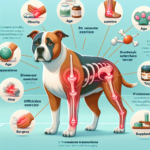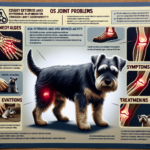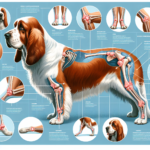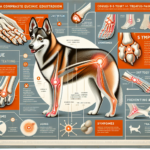Perro de Presa Canario Joint Pain: Causes, Symptoms, Prevention, and Treatment

Introduction
The Perro de Presa Canario, also known as the Canary Mastiff, is a large, powerful breed originating from the Canary Islands. Historically, these dogs were used for guarding livestock and property, as well as for dog fighting. Today, they are known for their loyalty, protective nature, and impressive physical strength. With a muscular build and a confident demeanor, the Perro de Presa Canario is a breed that commands respect and admiration.
Like many large breeds, the Perro de Presa Canario is prone to certain health issues, including joint pain. Joint health is a critical concern for this breed due to their size, weight, and activity level. Ensuring that these dogs maintain healthy joints is essential for their overall well-being and quality of life.
Breed-Specific Joint Pain Risks
Genetic Predisposition
The Perro de Presa Canario is genetically predisposed to several joint-related issues, including hip dysplasia, elbow dysplasia, and arthritis. Hip dysplasia is a condition where the hip joint does not fit properly into the hip socket, leading to pain and mobility issues. Elbow dysplasia involves abnormal development of the elbow joint, which can cause lameness and discomfort. Arthritis, a degenerative joint disease, is also common in this breed, particularly as they age.
Age-Related Risks
As the Perro de Presa Canario ages, the risk of developing joint pain increases. Typically, signs of joint issues may start to appear around middle age, which for this breed is around 5 to 7 years old. However, some dogs may show symptoms earlier, especially if they have a genetic predisposition or have experienced joint injuries.
Activity Level and Joint Stress
The Perro de Presa Canario is an active and energetic breed that requires regular exercise to stay healthy. However, their high activity level can also contribute to joint stress, particularly if they engage in high-impact activities such as jumping, running on hard surfaces, or intense play. Working dogs or those involved in sports may be at an even higher risk of joint issues due to the additional physical demands placed on their bodies.
Common Symptoms of Joint Pain in Perro de Presa Canario
General Symptoms
- Limping or favoring one leg
- Stiffness, especially after rest or exercise
- Reluctance to move, jump, or climb stairs
- Decreased activity level or interest in play
- Swelling or heat around the joints
- Whining or showing signs of discomfort when touched
Breed-Specific Symptoms
In the Perro de Presa Canario, joint pain may manifest more noticeably due to their size and weight. Owners may observe a pronounced limp or a significant decrease in the dog’s willingness to engage in physical activities. Additionally, due to their protective nature, these dogs may become more irritable or aggressive if they are in pain.
When to Consult a Vet
If you notice any of the above symptoms in your Perro de Presa Canario, it is important to consult a veterinarian promptly. Early diagnosis and treatment can help manage the condition and improve your dog’s quality of life. Persistent limping, severe stiffness, or any signs of significant discomfort should be addressed immediately.
Preventive Measures for Joint Health
Exercise Recommendations
Regular, moderate exercise is crucial for maintaining joint health in the Perro de Presa Canario. Activities such as walking, swimming, and controlled play are excellent options. Avoid high-impact exercises like jumping or running on hard surfaces, as these can exacerbate joint stress. Consistent, low-impact exercise helps keep the muscles strong and supports joint function.
Dietary Suggestions
A balanced diet rich in essential nutrients is vital for joint health. Consider incorporating foods or supplements that contain glucosamine, chondroitin, and omega-3 fatty acids, which support joint function and reduce inflammation. High-quality commercial dog foods formulated for large breeds often include these nutrients. Always consult your veterinarian before adding supplements to your dog’s diet.
Weight Management
Maintaining a healthy weight is one of the most effective ways to reduce joint stress in the Perro de Presa Canario. Excess weight puts additional pressure on the joints, exacerbating pain and mobility issues. Monitor your dog’s weight regularly and adjust their diet and exercise routine as needed to keep them at an optimal weight.
Early Screening and Monitoring
Regular veterinary check-ups are essential for early detection of joint issues. Screening tests such as X-rays or joint fluid analysis can help identify problems before they become severe. For breeds like the Perro de Presa Canario, early intervention can make a significant difference in managing joint health.
Treatment Options for Joint Pain
Non-Surgical Treatments
Non-surgical treatments for joint pain in the Perro de Presa Canario include medications, physical therapy, and lifestyle adjustments. Anti-inflammatory drugs and pain relievers can help manage symptoms, while physical therapy can improve mobility and strengthen the muscles around the joints. Lifestyle adjustments, such as modifying exercise routines and providing supportive bedding, can also alleviate discomfort.
Surgical Options
In severe cases, surgical intervention may be necessary. Common surgical options for joint pain include hip replacement, arthroscopy, and joint fusion. These procedures can significantly improve the dog’s quality of life, but they come with risks and require a thorough discussion with your veterinarian to determine the best course of action.
Alternative Therapies
Alternative treatments such as acupuncture, hydrotherapy, and massage can also benefit dogs with joint pain. Acupuncture can help reduce pain and inflammation, while hydrotherapy provides low-impact exercise that supports joint health. Massage therapy can improve circulation and relieve muscle tension around the joints.
Lifestyle and Management Tips
Daily Care Routine
A consistent daily care routine can help manage joint pain in the Perro de Presa Canario. This routine might include gentle exercise, a balanced diet, and regular administration of any prescribed medications or supplements. Monitoring your dog’s behavior and adjusting their routine as needed can also help manage their condition effectively.
Modifying the Home Environment
Making your home more comfortable for a dog with joint pain can significantly improve their quality of life. Consider adding ramps to help them navigate stairs, providing orthopedic beds for better support, and ensuring that their living area is free of slippery surfaces that could cause falls.
Long-Term Management
Long-term management of joint pain involves ongoing monitoring and adjustments to your dog’s care routine. Regular veterinary check-ups, maintaining a healthy weight, and providing appropriate exercise are all crucial components. Additionally, staying informed about new treatments and therapies can help you provide the best care for your Perro de Presa Canario.
FAQs About Perro de Presa Canario and Joint Pain
What are the early signs of joint pain in a Perro de Presa Canario?
Early signs of joint pain include limping, stiffness, reluctance to move, and decreased activity levels. If you notice any of these symptoms, consult your veterinarian for a thorough evaluation.
Can joint pain in Perro de Presa Canario be prevented?
While it may not be possible to prevent joint pain entirely, you can reduce the risk by maintaining a healthy weight, providing regular low-impact exercise, and ensuring a balanced diet rich in joint-supporting nutrients.
Are there specific exercises that are better for joint health in this breed?
Yes, low-impact exercises such as walking, swimming, and controlled play are ideal for maintaining joint health in the Perro de Presa Canario. Avoid high-impact activities that can stress the joints.
What dietary supplements are recommended for joint health?
Supplements containing glucosamine, chondroitin, and omega-3 fatty acids are commonly recommended for joint health. Always consult your veterinarian before adding any supplements to your dog’s diet.
When should I consider surgical options for my dog’s joint pain?
Surgical options should be considered when non-surgical treatments are no longer effective, and your dog’s quality of life is significantly impacted. Discuss the potential benefits and risks with your veterinarian to make an informed decision.
Conclusion
Joint pain is a common concern for the Perro de Presa Canario, but with proper care and attention, it can be managed effectively. By understanding the breed-specific risks, recognizing early symptoms, and implementing preventive measures, you can help ensure your dog maintains healthy joints throughout their life. Regular veterinary check-ups and a proactive approach to joint health are essential for keeping your Perro de Presa Canario active and happy. Remember, early intervention and consistent care are key to managing joint pain and improving your dog’s quality of life.




